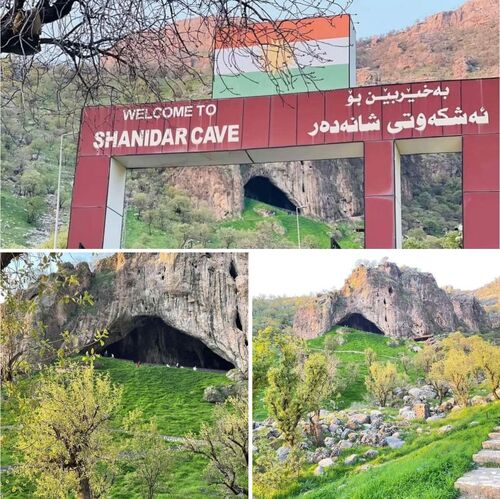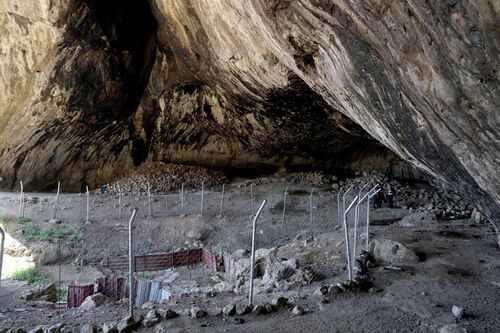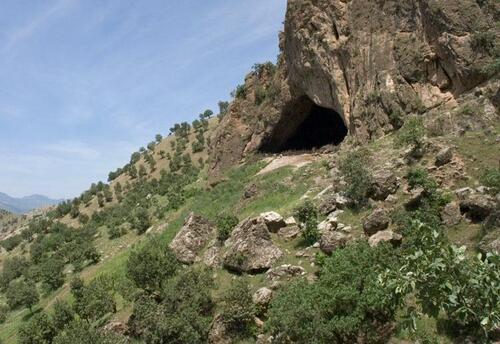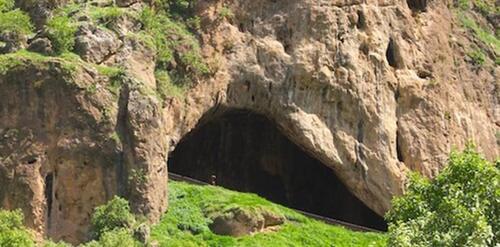The Shanadar Cave is one of the oldest and most historic caves in the Southern part of Kurdistan. Not only this cave is one of the oldest caves in the Kurdistan Region but it is also one of the oldest monuments in the world's history where humans had inhabited it once. This cave is located at the edge of Bradost Mountain in Barzan district which is on the border of Mergasour district and belongs to Hawler (Erbil) Province. In terms of altitude, it is 822 feet above sea level and it is 145 kilometers northeast of Hawler.

Shanadar is located in the upper part of a valley. The entrance to the cave looks like a triangle and it is 18 meters high and 25 meters wide. The sunlight comes into it easily. As we go north, it gets narrower and at the inner entrance of it, the cave gets so narrow that one has to lie down to be able to move around. There are trees, plants, and flowers at the outer entrance of the cave. Pers Mountain and Nazari Village are located across from the Shanadar Cave.

The History of Shanadar Cave
As we know, the Shanadar Cave has an ancient history and several European and American historians have studied it and found that the cave dates back to about 80,000 BC. and is considered to be the oldest and largest cave in Iraq.
In the 19th century, a group of workers in the German city of Dusseldorf found some bones. A biological teacher realized how important these bones were and called them "Neanderthal". The word "Neander" is derived from the name of a German musician priest and the word "Thal" in German means valley and it refers to the valley where bones were found. This is how the word Neanderthal was coined. Today, Neanderthals and Homo sapiens are known to have been contemporary with each other for a hundred thousand years and almost thirty thousand years ago the Neanderthals got extinct.
From 1953 to 1960 an American team under the supervision of archeologist Ralph Soliky regularly examined the Shanadar Cave. They were able to find many ancient bones that date back to 6000 to 3000 years ago.

During examination and excavation, Soliky noticed that in a layer of dust, several young and capable Neanderthal bones were found in the cave entrance and some small bones of prey were found among them. At the base of the cave, the bones of elderly people were found to have more food than the young people.
This discovery gave Shanadar cave a particular significance and made it a subject of an investigation into human history and many unknown aspects of this history. The history of the cave has been the answer to some of the historical questions of scientists.
Later, a British Cambridge team began searching and inspecting the historic Shanadar cave for five years which showed this was a place where Neanderthal humans had lived in. In 2018, a Neanderthal human skull was found in the cave.
In 2019, the same team continued testing, and another piece of a Neanderthal human skeleton was found.
According to experts, the discovery of these pieces of Neanderthal human bones is an important historical and archeological achievement and it is possible to present new data about the history of Shanadar Cave.

The discovery of Neanderthal human remains in this cave has passed through several stages
The first was the discovery of a Neanderthal man known as Nandy, and it was said by the researchers to be between 30 to 45 years old.
The remains of another man who is believed to be 30 years old were later found. He is estimated to have been 157 cm tall and the cause of his death was determined to be a rock fall.
The remains of another man aged 40 to 50 years old, were found and he appeared to have died of injuries. Despite his injuries and the presence of an object in his body, he even lived for two weeks with that injury.

The Word Shanadar
Shanadar consists of two compound words; "Shana" meaning cell and "dar" which means open or door and the word Shanadar means "an open cell".
Some sources claim that the reason for choosing this name is that it resembles bee cells. Based on another view the name Shanadar refers to the village that is close to it. There is also a weaker opinion that claims the word Shanadar means a place for kings to hide in.
The Shanadar Cave is now one of the most famous historical monuments in Kurdistan and every year a large number of people, Kurds, and tourists visit it as well as university and institution students especially students of the history department visit this cave for scientific purposes.








